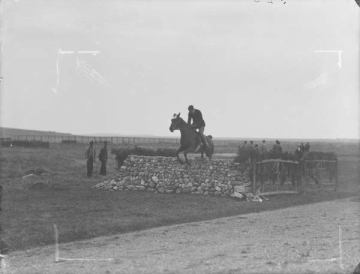Sport and Culture in Waterford in the early 20th century
By 1911 there was a long, illustrious history of horse racing in Waterford. The Waterford races date back at least to the eighteenth century. Various Marquises of Waterford were involved in the sport at a national level, sponsoring major races, developing race courses and serving as stewards with the Turf Club (the body which organised horse racing in Ireland). The Marquis of Waterford who was involved with horse racing in the 1840s and 1850s was also renowned as something of a practical joker. He once filled the first class carriage of a train bound for one race meeting with chimney sweeps, simply to see the looks on the faces of the other first class passengers.
Horse racing in Waterford benefitted from the spread of the railways. By 1901 the Great Southern and Western Railway was sponsoring races at the course in Tramore. By then the Tramore racecourse had been renovated by a local business man, Michael J. Murphy, who also developed a golf course which opened in 1894, built a grand hotel and installed street lighting in the town. In 1911 Murphy’s work suffered a setback when a high tide broke the embankments, flooded the golf course and swept away the hoardings from the racecourse. Murphy temporarily salvaged the race meetings, but he soon led the development of a new course near Tramore railway station.
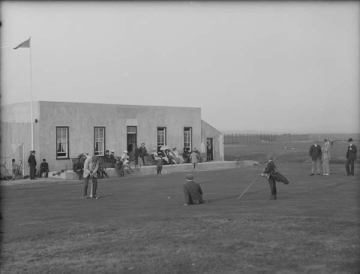
A mixed gathering follow the action on the putting green at the Tramore golf links, 18 September 1907. The course had opened in 1894.
(NLI, P WP 1692)
Waterford was also a strong GAA county. The local championships were fought out with passion. It took many years, however, for Waterford to enjoy success at inter-county level. When they finally won the All-Ireland hurling championship for the first time in 1948, the captain of the team was Jim Ware (see him at age 3), who played as goalkeeper. A bookbinder by trade with Harvey’s, he lived in Waterford city. He was, by the time he won his All-Ireland medal, almost 40 years of age. Success did not induce retirement. The following year, 1949, he captained Munster to win the Railway Cup.
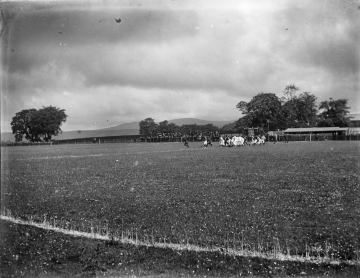
One of the earliest known action shots of hurling. This photograph was taken at the Gaelic field, Dungarvan in the 1890s.
(Waterford County Images)
The success of the GAA in promoting hurling in Waterford should not be underestimated. In 1884 when the GAA was founded there was no hurling played in Waterford. Men such as Dan Fraher did much to establish the game in the county. He opened his own drapery shop at 17 Grattan Square, Dungarvan which was known as 'The Gaelic Outfitting Store'. He leased land from Richard Curran at Shandon in 1885 which he developed into a sports ground. This was used for football, athletics, and later for the Dungarvan Agricultural Show and for visiting circuses. The field was later renamed ‘Fraher Field’. Fraher was also a promoter of the Irish language and started Irish classes in Dungarvan in 1888.
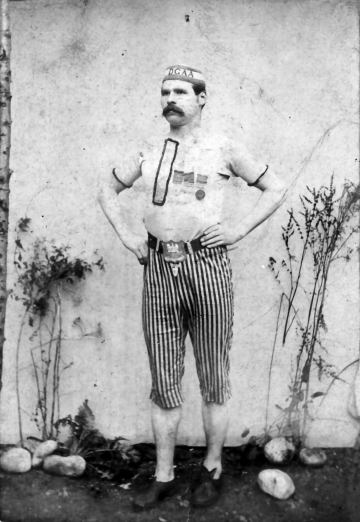
Dan Fraher, athlete and GAA administrator. Fraher opened his own drapery shop at 17 Grattan Square, Dungarvan. It was known as ´The Gaelic Outfitting Store'.
(Waterford County Images)
Fraher dominated the Waterford GAA county board and helped build a vibrant club scene in tandem with sporting enthusiasts all across the county. James Kirwan from Clonea, for example, founded the Clonea hurling club in 1902 and captained the team to win a county senior hurling title. He became captain of the Waterford senior hurling team during the time that Clonea won three successive championships.
James was one of five brothers, all of whom were accomplished athletes. His brother Rody was on the Waterford team that lost the 1898 All-Ireland football final to Dublin. Rody later played with Kerry when he moved there for the bank and won two All-Ireland senior football medals. A third brother, Percy, won over 300 hundred athletics competitions in a 20 year career, including almost a dozen Irish championships.
The Kirwans were part of a thriving athletics scene in Waterford. It was the home of the great Tom Kiely, the Olympic decathlon champion. Also present in the county was Peter O’Connor of Wilkin St., a solicitor with a large practice in Waterford, one of the most outstanding athletes in the world at the start of the twentieth century. He once held the world long jump record, and won gold and silver medals at the Olympic games in 1906. At the medal ceremony O’Connor refused to accept British colours and climbed a flagpole to hoist a green flag which bore the legend, ‘Erin go Bragh’. His world long jump record stood for twenty years and his Irish long jump record lasted for a full 90 years.
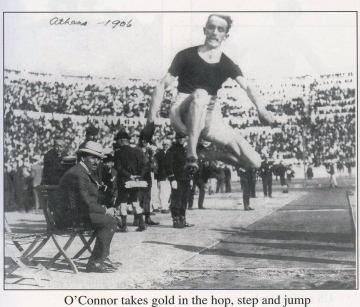
Peter O´Connor leaps to an Olympic silver medal in Athens, 1906. O'Connor would later climb the flagpole to unveil a large green flag on which was inscribed the words Erin go Bragh.
(Mark Quinn, The King of Spring: the Life and Times of Peter O'Connor 2004)
The schools of Waterford were also sporting hotbeds. Dungarvan-born George Henry Cooke attended Bishop Foy’s School at Grantstown in Waterford and was secretary to the school’s rugby and cricket teams, for both of which he played. He later went on to serve in high-ranking positions in the Indian civil service.
In general, the sporting scene in Waterford was a diverse one. In 1869 the first cycling club in Ireland had been founded in Dungarvan by Richard E. Brenan. That same year they held a cycle race for a challenge cup which Brenan won. Brenan was also a photographer, published a local newspaper and ran a printing and stationery business. By 1911 there were five cycling clubs (see return for William Cordner, cycle agent, in Tramore) in Waterford city, as well as rugby and soccer clubs, a cricket club, a tennis club and a gun club.
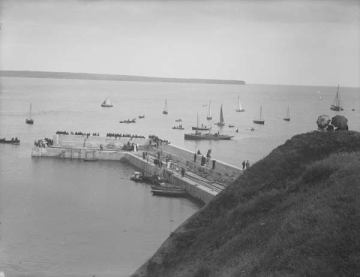
Sitting on the dock of the bay: onlookers at Tramore watch as the small boats come into dock, 1907
(NLI, P WP 1721)
The hotels of Tramore and other Waterford resorts along the coast were attractive to holiday makers and day-trippers. The growth of the railways (see return for Arthur Prossor, Railway Secretary at Tramore) made the Waterford coast much more accessible as a tourist destination. Tramore had its hotels and those who worked there hailed from counties all across Ireland (see return for Murphy’s Hotel in Hotel Square)
In Dungarvan, a Town Park was built from money left in a bequest to the townspeople by William Gibbons on his death in 1894. One of the trustees of the will who oversaw the project was Borough Surveyor, Michael Beary of Sexton St.. The park and bathing area opened in 1896, though it was soon vandalised, but continued to attract generations of visitors.
Some of those who visited Waterford did so, not for the seaside, but for the antiquity and heritage of the region. Amongst the most noted cultural artefacts in Waterford were Ogham stones, found by William Williams at Kilgrovan in 1857. Around 1900 the five stones – carved with the Ogham alphabet – were transferred to Mount Melleray in Waterford, in a move orchestrated by Rev. Patrick Power, a Waterford man who went on to become professor of archaeology at University College Cork. In 1932 Rev. Power published a book on the Kilgrovan Stones.
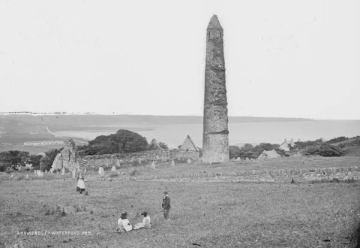
A life of leisure: Children play in the field in front of the round tower at Ardmore, Co. Waterford
(NLI, LCAB 00789)
Other important books came from the county. Richard John Ussher, from the long-established Ussher family at Cappagh, was a renowned ornithologist who had been the lead author of the 1906 publication Birds in Ireland. His cousin, Perceval Arland Ussher, attended Trinity College Dublin and St. John’s College, Cambridge. He became a devotee of the Irish language, and published two books in Irish, as well as producing a translation of Brian Merriman’s Cúirt an Mheán Oíche in 1926. Another author who lived in Waterford was Frances Curry. She was also a well-known painter and shared a house on Main St. in Lismore with her friend Helen O’Hara. In 1877 the women collaborated on a children’s book called Prince Ritto.

